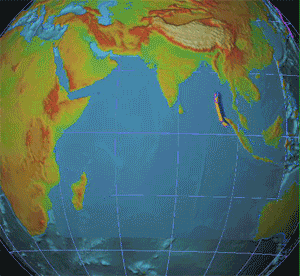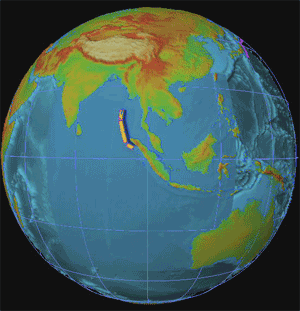LOCATION Meeru Island Resort, fondly known as Meeru by friends, offers a relaxing casual atmosphere. A large island by local standards, much of the island remains untouched, with its natural vegetation intact. It is certainly the resort for you if you would prefer to kick off your shoes and enjoy a casual atmosphere in which to relax.

The island is covered in soft white sand. The floors of the reception and other public areas too are layered with soft sand.
As you approach the island you will be surprised at the lack of any man-made structures visible through the thick vegetation of the shoreline, fringed with tall coconut palms.
Winding walkways lined with palm trees lead you to the reception with its thatched roofing that blends in perfectly with the natural surroundings. We offer you the Maldives, simply at its best.
However there is nothing simple about the services we provide or the facilities available at the resort. All this is provided without pomp and formality.
Meeru has one of the biggest dive schools in the country, and its remote location in Male' Atoll gives it access to many excellent dive sites that are hardly ever visited by any others.
However you do not have to be a diver to enjoy Meeru. There are a variety of other water sports and land sports that you will certainly enjoy.
None of this is important if you wish to take part in the most popular holiday activity here - relaxation. The island is large enough for you to find your own private little hideaway on the beach for the day. Or simply find a perch at the popular poolside and spare yourself the effort.
ACCOMMODATION
We offer a choice in the type of accommodation for your stay on Meeru. All are comfortable and provides all the basic amenities. However some provide more comforts than the others with more space and privacy.
All the rooms are air-conditioned and equipped with ceiling fan. All provide the convenience of en suite bathroom, IDD telephone and mini fridge.
276 Rooms including 76 Standard, 77 Land Villas, 61 Jacuzzi Villas, 29 Water Villas, 30 Jacuzzi Water Villas, 2 Honeymoon Suites, the Coral Suite and the Dolphin Suite. All rooms features tropical décor, two twins, one queen or one king size bed, tile or wood floors, private patio with furniture, air-conditioning, overhead ceiling fan, sitting area, stocked Mini Bar with refrigerator, tea/coffee machine, IDD telephone, personal safe, bathroom with hot water, shower, bath accessories, hair dryer, and nightly turndown service. Electricity is 220VAC, 50HZ. Also provided is complimentary use of chaise lounges at the pool and beach and beach towel Tariffs are quoted in US$ per Room, per Night, Full Board, and include Bed Tax
DINING AND BARS

No fuss dining, just good food is the order of the day at Meeru. No dressing up to impress. Just stroll in from the beach or from your room and sit down and enjoy. The only house rule is, no wet suits or wet clothes are allowed in the dining area.
There is one restaurant, two coffee shops and three bars where you will find everything you want, and at all hours of the day. So just continue to have fun and there'll be plenty of food on offer just when you want it.
The Farivalhu Restaurant, the main dining room, with traditional sand floor, serves “all you can eat” buffet style meals for breakfast, lunch and dinner, for Meal Plan guests; and as well, three “optional” a la carte restaurants - The Hungaanu Coffee Shop, serving an all day dining menu; The Asian Wok, specializing in Thai, Indian, Chinese and Maldivian cuisine; the Hagern, serving a grilled seafood menu aboard a “restaurant” yacht anchored in the lagoon; and two other “optional” choices, Room Service, and a selection of very special dinners served on the Beach!
The Dhoni Bar, located on the beach, beside the pool; the Kakuni Bar, featuring sports bar facilities such as table games and all day, color satellite TV coverage of international sporting events; the Club 1919 Bar, aboard a yacht anchored in the lagoon; the Beach Bar at the southern end of the island; and a “bar cart” on wheels, providing a convenient service to guests lounging along the beach.
SPORTS SERVICES
Although Meeru is perfect for a relaxing holiday just lazing on the beach we also have a wide selection of activities for those people who want to enjoy some exciting land or water sports. You can have loads of fun, both in, out of and on the water, so you won't be able to complain of having nothing to do.
 ACTIVITIES
ACTIVITIES
Much as you'd expect from a resort that prides itself on being a place for those who have energy and want to have some fun, we offer an action packed itinerary for you to choose from. You can pick any number of activities that will give you an experience to remember.
DIVINGMany visitors come to the Maldives to enjoy the unique, beautiful under water scenery. With excellent dive sites in the area Meeru is the ideal choice for a diving holiday.
More than 50 dive spots offer something for everyone. Leisurely dives on reefs protected from strong currents exciting drift dives in channels and wreck dives.
The marine life includes a fantastic variety of hard and soft corals, dense schools of reef fish and regular encounters with dolphins, sea turtles and pelagic fish like Manta Rays, Eagle Rays, Sharks, Barracudas and Tunas.
Ocean-Pro also offers snorkelling excursions and courses. On these popular trips 2 reefs are visited and dolphins, turtles and rays can be seen.
SPAThere are many paths to wellness. Duniye Spa offers an exquisite range of treatments to start you on your journey. Our menu is flavoured by the world's time-honoured beauty, healing and rejuvenation traditions. These ancient traditions are reflected in the way the treatments are delivered-with mindfulness, grace and a spirit of generosity.
At Duniye Spa our philosophy follows a natural approach to body and skin care which infuses ancient beauty therapies. Our Thai, Indian and Balinese Staff are trained professionally in the health and beauty industry and deliver treatments from the heart and give for the sheer joy of giving.
For the ultimate Spa experience, enjoy a package to discover total wellness or simply enjoy one of the various treatments offered from our diverse Spa Menu. An unforgettable experience awaits you.































